Asian continent
 |
|
| Area | 44,579,000 km2 (17,212,000 sq mi) |
|---|---|
| Population | 4,164,252,000 (1st) |
| Pop. density | 87/km2 (225/sq mi) |
| Demonym | Asian |
| Countries | 48 UN members 6 other states |
| Dependencies | |
| Non-UN states | |
| Languages | List of languages |
| Time zones | UTC+2 to UTC+12 |
| Internet TLD | .asia |
| Largest cities | |
Major urban areas in Asia
List of cities in Asia
Asia (![]() i/ˈeɪʒə, ˈeɪʃə/) is Earth's largest and most populous continent, located primarily in the eastern and northern hemispheres and sharing the continental landmass of Eurasia with the continent of Europe. Asia covers an area of 44,579,000 square kilometres (17,212,000 sq mi), about 30% of Earth's total land area and 8.7% of the Earth's total surface area. The continent, which has long been home to the majority of the human population, was the site of many of the first civilizations. Asia is notable for not only its overall large size and population, but also dense and large settlements as well as vast barely populated regions within the continent of 4.4 billion people.
i/ˈeɪʒə, ˈeɪʃə/) is Earth's largest and most populous continent, located primarily in the eastern and northern hemispheres and sharing the continental landmass of Eurasia with the continent of Europe. Asia covers an area of 44,579,000 square kilometres (17,212,000 sq mi), about 30% of Earth's total land area and 8.7% of the Earth's total surface area. The continent, which has long been home to the majority of the human population, was the site of many of the first civilizations. Asia is notable for not only its overall large size and population, but also dense and large settlements as well as vast barely populated regions within the continent of 4.4 billion people.
In general terms, Asia is bounded on the east by the Pacific Ocean, on the south by the Indian Ocean and on the north by the Arctic Ocean. The western boundary with Europe is a historical and cultural construct, as there is no clear physical and geographical separation between them. The most commonly accepted boundaries place Asia to the east of the Suez Canal, the Ural River, and the Ural Mountains, and south of the Caucasus Mountains and the Caspian and Black Seas.
...
Wikipedia
